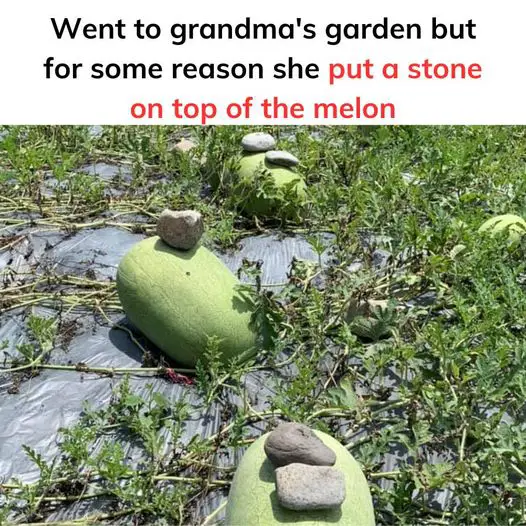When I walked into my grandmother’s garden, I was intrigued by the sight of stones placed on top of the melons. Curious about this peculiar gardening practice, I asked her for an explanation. She smiled and shared the reasoning behind it, blending tradition with practical wisdom.
1. Bird Deterrence
One of the main reasons for placing stones on melons is to deter birds. Birds often peck at the fruit, causing damage. The stones create an unstable surface, making it difficult for birds to land and feed, which scares them away and protects the melons.
2. Marking Ripe Melons
Gardeners use stones to mark melons that are ripening. This method helps them track which melons will soon be ready for harvest. Watermelons typically take about a month to ripen after they start fruiting. By placing a stone on a nearly ripe melon, it’s easier to monitor and manage the harvest.
3. Sunlight Management
Stones also help protect melons from excessive sunlight, which can cause sunburn or premature ripening. Acting as small shields, the stones provide shade, reducing the risk of sun damage and helping maintain the quality of the fruit.
4. Ensuring Even Growth
Placing stones on melons can contribute to even growth. As melons expand, they can grow in different directions. A stone helps distribute the weight more evenly, encouraging a more uniform shape, which is especially important for commercial growers who need consistent-looking produce.
5. Improving Melon Quality
Using stones can enhance the overall quality of melons. By controlling growth patterns and shielding the fruit from external factors like birds and excessive sunlight, melons can develop better texture, flavor, and appearance. This traditional technique, passed down through generations, continues to ensure a good harvest.
Exploring Traditional Gardening Techniques
Grandma’s garden is not just a place for cultivating fruits and vegetables; it’s a living repository of traditional knowledge and techniques refined over centuries. These methods, though simple, often have scientific reasoning behind them, reflecting a deep understanding of nature and an intuitive approach to gardening.
For example, she practices companion planting, where certain crops are planted together to benefit each other through pest control, pollination, and nutrient sharing. Marigolds are often planted alongside tomatoes because they help repel harmful insects.
Additionally, Grandma collects rainwater in barrels to water her garden, providing natural, untreated water that the plants thrive on. This practice conserves water and promotes healthier growth.
Sustainability in the Garden
Sustainability is at the core of Grandma’s gardening philosophy. She composts kitchen waste to create rich, organic fertilizer, reducing waste and enriching the soil with nutrients for healthy plant growth.
She also practices crop rotation to maintain soil fertility, allowing the soil to replenish its nutrients naturally and reducing the need for chemical fertilizers. This method helps prevent soil depletion and supports a balanced garden ecosystem.
Lessons for Modern Gardeners
Modern gardeners can learn valuable lessons from these traditional practices. While modern technology and methods have their benefits, incorporating age-old techniques can lead to a more holistic and sustainable approach to gardening. These practices remind us that sometimes, the simplest solutions are the most effective.
Using stones on melons might seem quaint, but it highlights the ingenuity of past generations. These practices, born out of necessity and observation, have stood the test of time and remain relevant today.
Conclusion
Next time you see stones on melons in a garden, you’ll understand the multifaceted reasons behind this practice. From deterring birds and marking ripening fruit to managing sunlight and ensuring even growth, these stones play an important role in the life cycle of the melons. Grandma’s garden is a treasure trove of wisdom, demonstrating that sometimes, the best way forward is to look to the past

